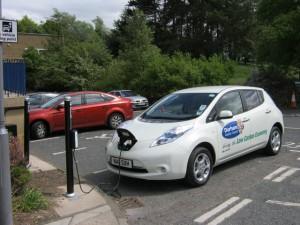 Electric vehicles (EVs) have been accepted as greener alternatives to traditional vehicles, but since EV technology is so new, their comparative environmental impact is not fully understood. In an attempt to shed light on this issue, a study from Norway set out to compare the life cycle analysis (that is, production, use, and end of life impacts) of EVs and internal combustion engine vehicles (ICEVs), as directly as possible. Their results have sparked debate over the idea of “problem shifting” and the rationality of widely promoting EV technology.
Electric vehicles (EVs) have been accepted as greener alternatives to traditional vehicles, but since EV technology is so new, their comparative environmental impact is not fully understood. In an attempt to shed light on this issue, a study from Norway set out to compare the life cycle analysis (that is, production, use, and end of life impacts) of EVs and internal combustion engine vehicles (ICEVs), as directly as possible. Their results have sparked debate over the idea of “problem shifting” and the rationality of widely promoting EV technology.
Production: The authors estimate that during production, EVs produce approximately twice the amount of greenhouse gases compared to ICEVs. Battery production (35-41 percent) and powertrain components (16-18 percent) account for the majority of this increase. It would therefore be very detrimental to replace the batteries in an EV. Human toxicity potential (HTP) is another startling area for EVs. Depending on the type of batteries used, the authors estimate that EV production causes between 180 and 290 percent greater HTP—the biggest sources of which can include copper, nickel, and other mining practices throughout the battery production process. The authors note, however, that significant efficiencies are likely to be found given the rapid expansion of the industry.
Use: One of the main criticisms of EVs is that they are only as green as their source of electricity. While this is true to a large extent, the study found that, assuming a 150,000km (93,000 mile) lifetime, EVs have lower global warming potential (GWP) than gasoline vehicles by roughly 27 percent if powered by coal, 22 percent if powered by “average” European electricity, and 12 percent for natural gas. The study also adjusted GWP reductions based on vehicle lifetimes of 100,000km (9-14 percent) and 200,000km (28 percent) for “average” European electricity. Under more extreme scenarios, the authors estimate that wind power would lead to a “life cycle carbon footprint” of just 106g of carbon dioxide per kilometer, whereas using electricity produced by lignite would lead to 352g of carbon dioxide per kilometer. This means that if you added the carbon dioxide produced in all 3 life cycle phases of an electric vehicle and divided it into its lifetime mileage (resulting in 106g per kilometer), it would be lower than the carbon dioxide level of 130g per kilometer mandated by the European Union in 2009 for all new vehicles. If an EV is running on lignite, however, the study says it would be much higher than ICEVs.
End of Life: Surprisingly, the study found that end-of-life treatment, which includes material recovery and disposal, adds only a small contribution across the impact categories.
Though some have criticized the study as being biased against EVs, it nonetheless offers a thought-provoking life cycle analysis of EVs and ICEVs. The authors conclude that while EV technology is a crucial component in reducing vehicles’ footprints, it cannot be “harnessed everywhere and in every condition.” So, is your EV greener than a traditional vehicle? Almost certainly, but it depends.

